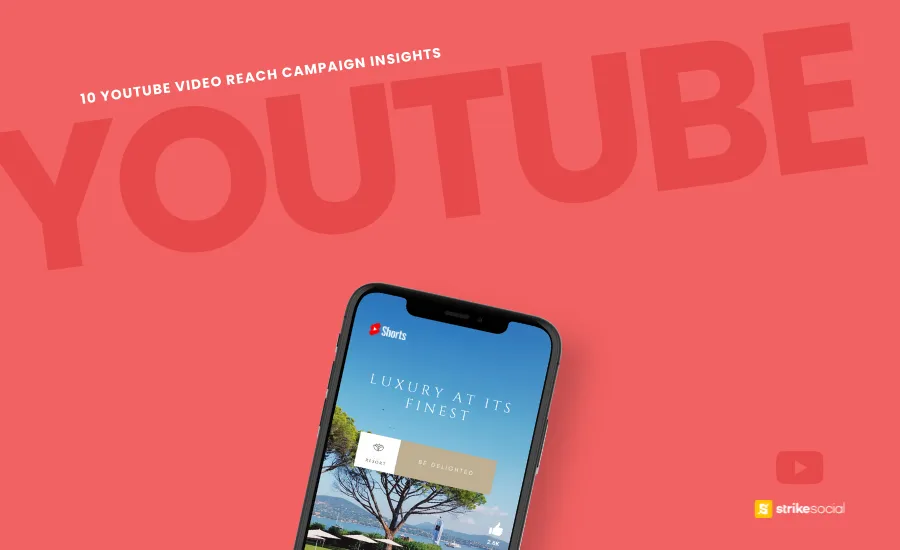Strike Overview
- Suppose you are considering whether a YouTube Video Reach campaign suits your summer promotion, back-to-school campaign, or any social media advertising effort. In that case, our data can help you make informed decisions.
- For a comprehensive understanding of YouTube VRC, our previous blog provides an overview of available options for media buyers and detailed instructions for campaign setup. However, if you want to analyze data on the YouTube Video Reach Campaign and its performance, you’re in the right place. Our 2024 data will offer insights to support your upcoming YouTube campaign.
- The content of this blog comprises YouTube video reach campaign insights and in-depth analysis, offering an insider’s viewpoint on our team’s data interpretation, campaign management, and successful ad outcomes.
Jump to Section
- 10 YouTube Video Reach Campaign Insights That Advertisers Should Know
- 1. Campaign Comparison – Click-Through-Rate (CTR) Analysis
- 2. Campaign Comparison – Cost Per Engagement (CPM) Analysis
- 3. Creative Distribution by Flight Duration
- 4. Cost Per Impression by Flight Duration
- 5. Distribution of Creative by Video Duration
- 6. View Through Rate (VTR) by Video Duration
- 7. Impression per Dollar by Video Duration
- 8. Engagement Efficiency by Video Duration
- 9. View Drop-off Rate by Video Duration
- 10. Video Reach Campaign for Conversion Objective
- Maximizing Your YouTube Video Reach Campaigns
10 YouTube Video Reach Campaign Insights That Advertisers Should Know
Let’s examine the metrics that distinguish Video Reach Campaigns from other YouTube ad formats. Our team obtained data on US campaigns utilizing VCR to boost impressions for this analysis. These YouTube ads’ flight dates were within Q1 of 2024. We will analyze the data from a creative data report perspective.
Comparing YouTube Video Reach Campaign to TrueView Instream Non-Skippable
1. Campaign Comparison – Click-Through-Rate (CTR) Analysis
The YouTube VRC click-through rate (CTR) has shown superior performance to the Non-Skippable Campaign, boasting a higher CTR of 0.08% versus 0.05%, per the Strike Social 2024 benchmark data. Our analysis indicates that VCR campaigns effectively drive viewers to interact with ads, resulting in a higher click-through rate.
The YouTube Video Reach Campaign, Efficient Reach, employs a mixed ad format, allowing Google AI to adjust dynamically based on ad placement performance, leading to increased ad engagement.
The higher Click-Through Rate (CTR) for Video Completion Rate (VCR) indicates that viewers engage more and are more likely to interact with ads they watch to completion than viewers who focus on watching without the option to skip. While non-skippable ads guarantee viewers see the message, they might only sometimes promote interaction compared to VRC.
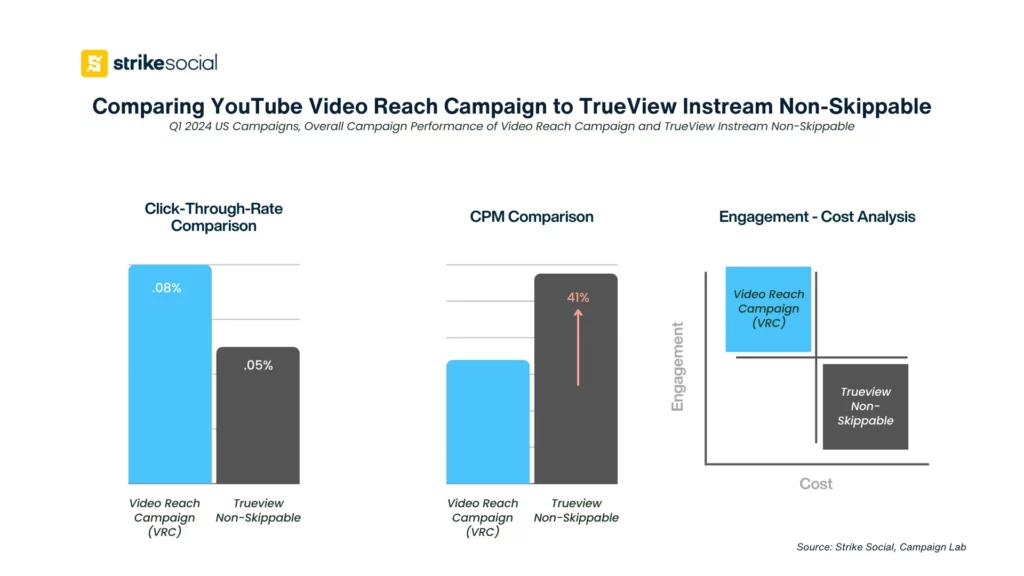
2. Campaign Comparison – Cost Per Engagement (CPM) Analysis
In comparing the 2024 overall CPM between the YouTube Video Reach Campaign insights and findings from Trueview Instream Non-Skippable ad formats, the VRC showed a 41% lower CPM than Trueview. The difference in costs indicates that media buyers can achieve more impressions for their budget by choosing the Video Reach campaign ad format.
The lower CPM of VCR campaigns suggests that these ads are more effective in reaching a broad audience without significantly increasing spending. For advertisers focused on maximizing their budget, VCR campaigns offer a compelling advantage by delivering more impressions at a lower cost. This efficiency and higher engagement rates make VCR campaigns an excellent strategy for advertisers seeking to enhance their reach and interaction rates without exceeding planned ad allocation.
The lower CPM of VRC campaigns indicates their effectiveness in reaching a broad audience. The ad format efficiency and higher engagement rates position VRC campaigns as a strategy for marketers looking to expand their reach during holiday advertising efforts without exceeding their planned ad allocation.
YouTube Video Reach Campaign Flight Behavior Data and Performance
3. Creative Distribution by Flight Duration
Most campaigns (68%) are designed to run for 31 days and above, while a smaller proportion (32%) are set for shorter durations of 8-30 days. This distribution suggests advertisers prioritize sustained engagement and continuous presence in their audience’s view.
Always-on campaigns allow for extended exposure, potentially building brand recognition and loyalty. However, it’s also essential to consider the strategic use of shorter campaigns for tentpole advertising efforts, which might be employed for time-sensitive promotions, product launches, or events that require a quick but intense burst of advertising.
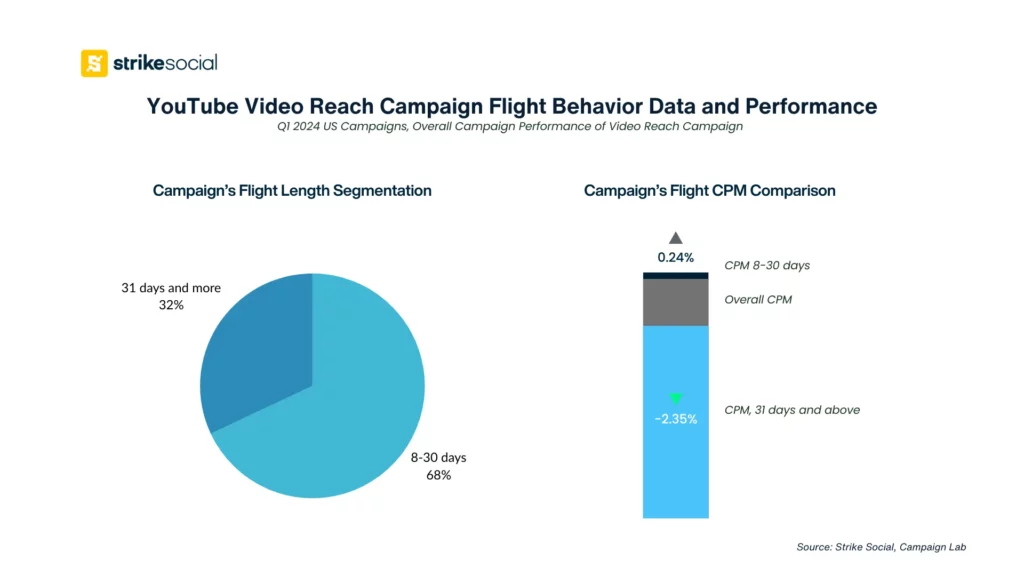
Advertisers’ choice between long and short campaigns should align with their marketing objectives. While longer campaigns dominate, integrating shorter, high-impact campaigns can complement the broader strategy by targeting specific events or promotions.
Further Reading
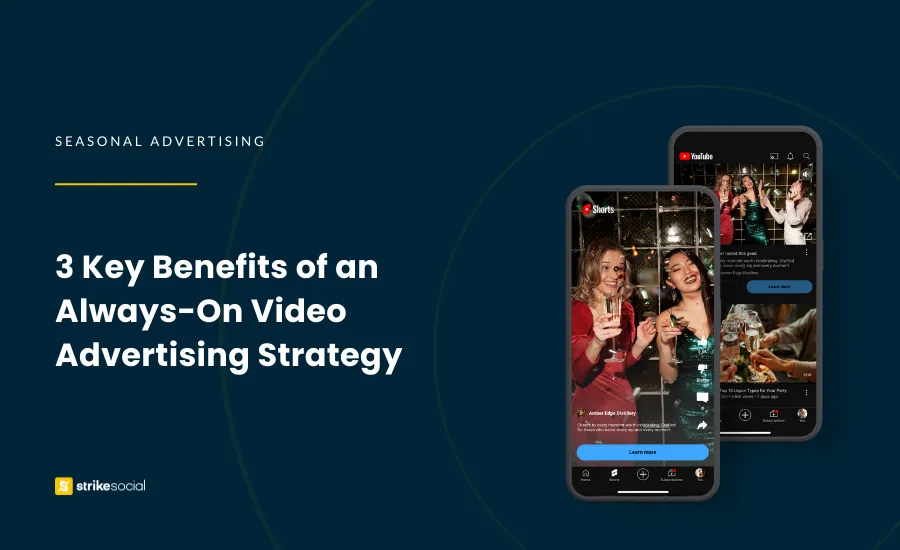
Is Always-On Advertising A Good Fit For Your Brand?
With consumer habits shifting before, during, and after key events, an always-on advertising strategy ensures your brand stays connected throughout. From building excitement to sustaining engagement after the event, your ads should never take a break.
4. Cost Per Impression by Flight Duration
Campaigns running for 31 days and above have a slightly lower CPM, 2.35% higher than the overall ad cost, than those running for 8-30 days. The overall CPM across all campaigns indicates a marginal difference in cost efficiency between the two flight durations.
The CPM data suggests that longer (31 days and above) and month-long campaigns (8-30 days) are closely identical. The marginal difference could be due to several factors, including the potential for optimized ad delivery over a more extended period and the ability to fine-tune targeting and bidding strategies as the campaign progresses.
Further Reading
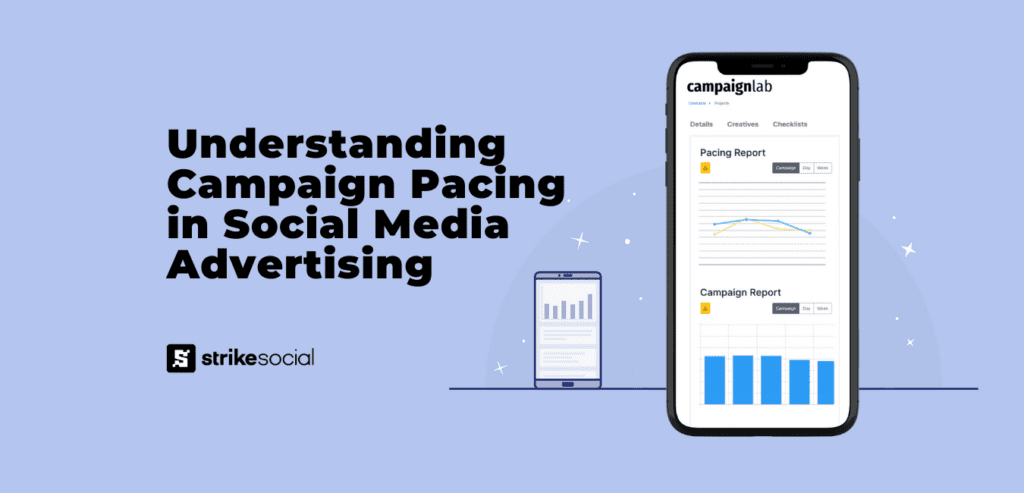
Why Proper Campaign Pacing Drives Digital Ad Results
Effective pacing is the backbone of a successful social media advertising strategy. Spotting early signs of underpacing or overpacing is key to maintaining performance, optimizing spend, and achieving your campaign objectives.
Longer campaigns, or Always-on, may also benefit from economies of scale, where the cost per impression decreases as impressions increase over time. For media buyers, this slight cost efficiency in longer campaigns can translate into better campaign management, allowing for more impressions and extended reach within the same budget by pacing appropriately.
Strike’s data shows a slight difference in CPM. Strategic objectives should primarily drive the choice for campaign flights rather than cost considerations alone.
2024 Q3 YouTube Benchmark Report
Our latest YouTube CPV report analyzes the cost trends, view duration, and device performance changes across various industries. Discover how YouTube campaigns performed and id
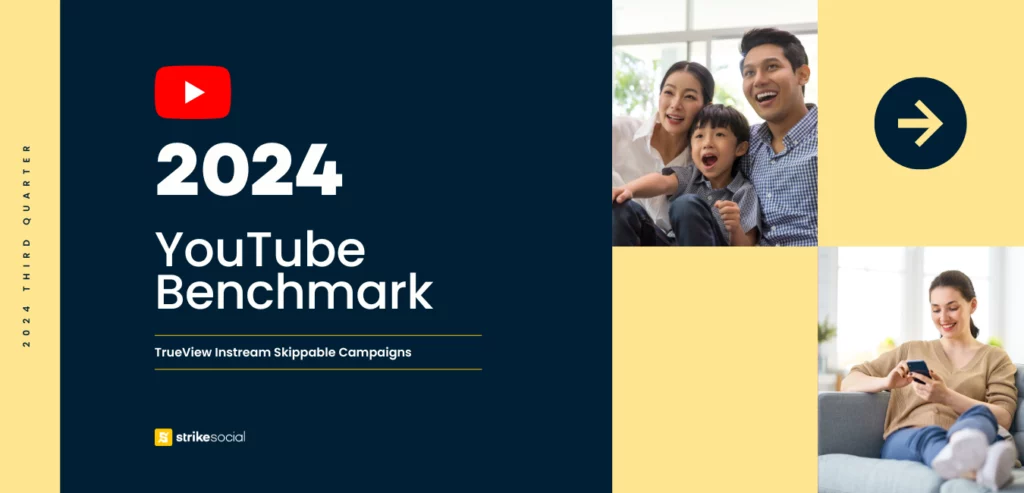
Analyzing Video Duration: Distribution, VTR, Reach, Engagement, and View Drop-off for YouTube Video Reach Campaign
5. Distribution of Creative by Video Duration
Most Strike Social YouTube ads set up for VRC utilized a 30-second video ad, followed by a 15-second ad, and lastly, a 6-second ad, representing 43%, 31%, and 19% of the ads, respectively.
This pattern indicates that advertisers are inclined to use YouTube Video Reach Campaigns to prioritize longer formats, potentially due to their ability to deliver detailed messages and captivate the audience effectively.
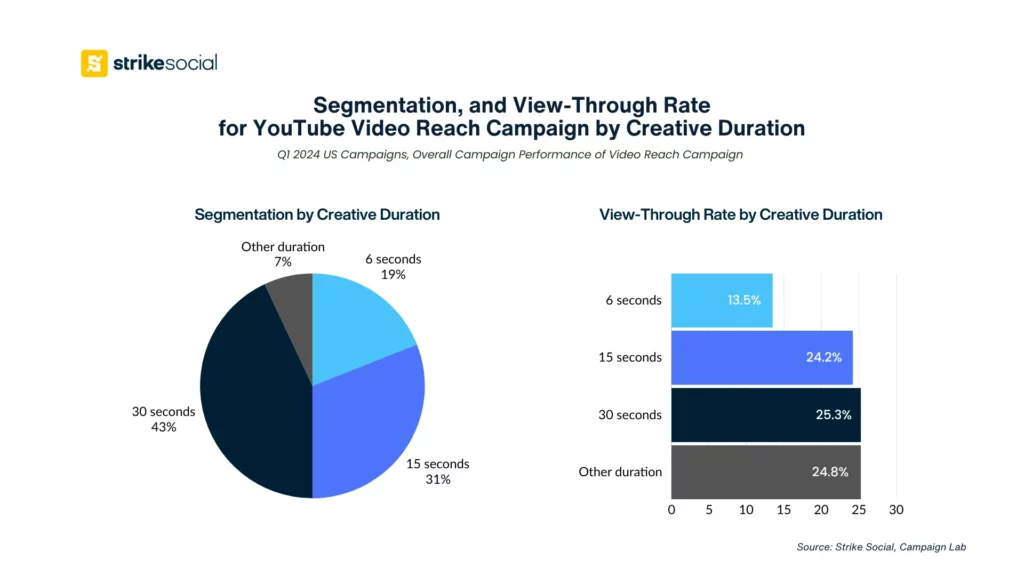
This preference aligns with the Efficient Reach option and VRC ad feature, which leverage the extended duration to engage viewers deeply through Shorts ad placement. The next most popular format is the 15-second ad, at 30.56%, often employed in the 15-second non-skippable ad format, striking a balance between message delivery and viewer retention.
6. View Through Rate (VTR) by Video Duration
Strike Social YouTube ad data shows that longer video durations result in higher View Through Rates (VTRs), with 30-second videos leading at 25.27% and 15-second videos closely following at 24.23%. This implies that TrueView In-Stream Skippable Ads effectively maintain viewer engagement, likely due to their comprehensive content and engaging storytelling. Even viewers of short videos are drawn to watch video ads if the ad creative is compelling.
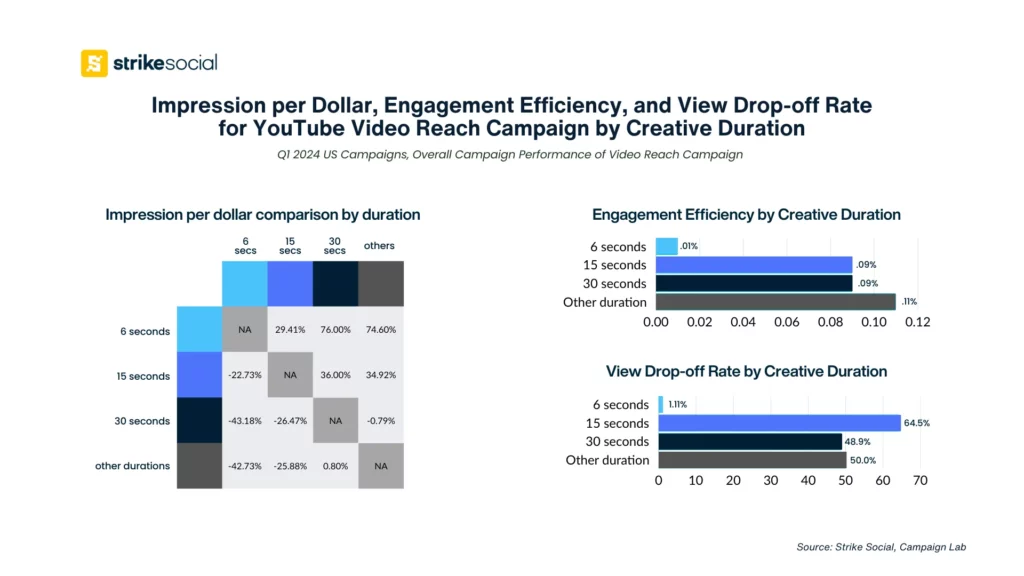
The 6-second videos, with a VTR of 13.48%, indicate that although they are effective for quick impressions, the ad creative should make a substantial impact quickly to retain viewer attention. Our data accentuates the significance of longer ads in campaigns targeting sustained viewer engagement.
7. Impression per Dollar by Video Duration
Our Q1 2024 YouTube VRC data analysis found that 6-second video ad creatives deliver the highest impressions per dollar compared to longer formats. Specifically, 6-second videos generate 29% more impressions than 15-second ads and 76% more impressions than 30-second ads.
These findings underscore the cost-effectiveness of short video ads for broad awareness campaigns. This aligns with the primary purpose of bumper ads, which is to convey quick, memorable messages to a wide audience at a reduced cost.
8. Engagement Efficiency by Video Duration
Our data demonstrates that while high impressions do not always lead to higher engagement, 15-second, and 30-second videos exhibit the highest engagement efficiency at 0.09%. This suggests that these formats are more effective at driving user interaction.
This finding is particularly relevant for TrueView In-Stream Ads, which can be skipped after 6 seconds but yield strong engagement if the content is compelling. On the other hand, 6-second videos, while cost-effective for reaching a wider audience, display lower engagement efficiency at 0.01%, indicating that ad formats tailored for short video ads prompt less ad engagement compared to longer formats.
9. View Drop-off Rate by Video Duration
The data on view drop-off rates reveals that 6-second videos exhibit the lowest drop-off rate at -1.11%, indicating a high likelihood of viewers watching the videos in their entirety. This finding shows the efficacy of YouTube bumper ads in retaining viewer attention for brief durations. Conversely, 15-second videos have the highest drop-off rate at -64.51%, followed by 30-second videos at -48.95%, suggesting that longer videos, although beneficial for engagement and VTR, encounter significant challenges in sustaining viewer attention.
An effective YouTube video reach ad strategy involves harnessing the educational aspect and incorporating “sticky points” within video content. However, merely presenting information is insufficient. Advertisers must integrate “sticky points” into their videos to captivate attention. These points may consist of intriguing, surprising, or relevant moments that leave a lasting impression on viewers. They can be achieved through diverse techniques like thought-provoking questions, compelling visuals, or interactive elements.
YouTube Video Reach Campaign Data for Conversion Objective
10. Video Reach Campaign for Conversion Objective
When running YouTube Video Reach Campaigns with a conversion objective, it’s important to note that 15-second and 30-second videos have distinct advantages. The 15-second video demonstrates higher conversion efficiency and better VTR and VCR, making it ideal for quick engagement and conversion.
On the other hand, the 30-second video provides higher overall engagement, cost-effective impressions, and clicks, suggesting that it can deliver a deeper message and engage viewers more comprehensively.
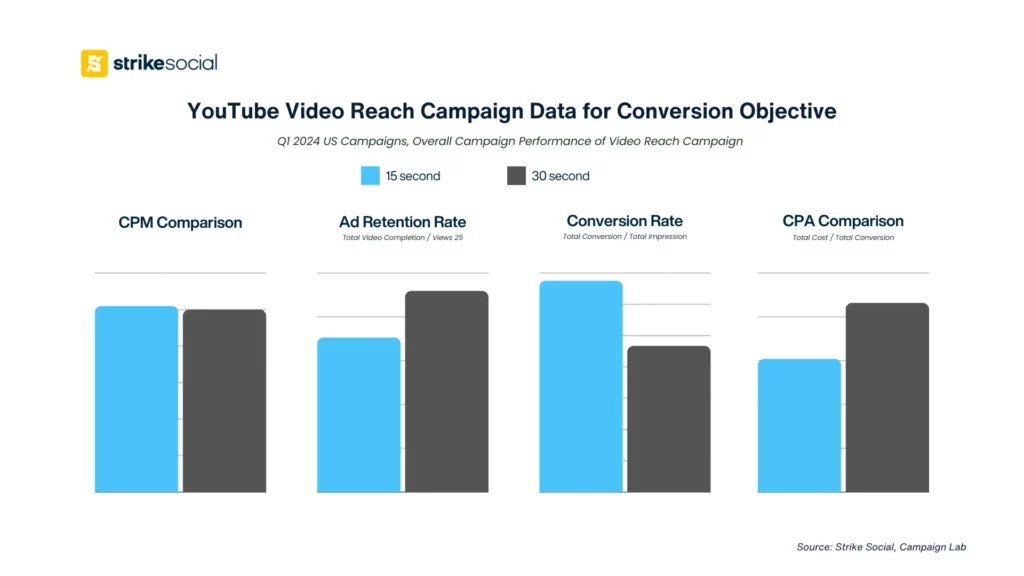
Advertisers should consider their specific campaign goals and audience behavior when selecting video durations. Based on our data, shorter videos may be more effective if immediate conversions and focused messaging are the priority. Longer videos might be the better option for comprehensive engagement and a broader reach. A balanced approach utilizing both formats within a campaign can optimize overall performance, leveraging the strengths of each video duration to achieve the desired outcomes.
Maximizing Your YouTube Video Reach Campaigns
Our Q1 2024 data analysis provides YouTube video reach campaign insights into leveraging this format for your next holiday campaign. By understanding the engagement rates of longer video formats and the cost efficiencies of shorter ads, advertisers can refine their strategies for maximum impact.
Highlights from our YouTube Video Reach Campaign data:
- Higher CTR and Lower CPM with VRC: Video Reach Campaigns outperform non-skippable ads regarding click-through rates and cost per thousand impressions (CPM), making them a cost-effective choice for advertisers aiming for broad reach and engagement.
- Strategic Use of Video Durations: Based on our data, 30-second videos excel in engagement and comprehensive messaging, while 6-second bumper ads offer cost efficiency in generating impressions.
- Balancing Campaign Durations: Longer campaigns (31+ days) slightly edge out shorter campaigns regarding cost efficiency, making them ideal for sustained engagement and brand loyalty. However, shorter, high-impact campaigns are essential for time-sensitive promotions and events.
- Enhanced Engagement with Longer Videos: Longer video ad formats (15 and 30 seconds) demonstrate higher engagement efficiency, crucial for driving user interaction and conversions.
Applying these YouTube video reach campaign insights to your advertising strategy allows you to tailor your YouTube ad campaigns to maximize reach, engagement, and conversions.
Contact our team today to discuss how we can help optimize your advertising strategy and achieve your marketing goals. Our media buyer expert is available to assist you in implementing these insights into your campaigns. Get in touch with us now to get started!


